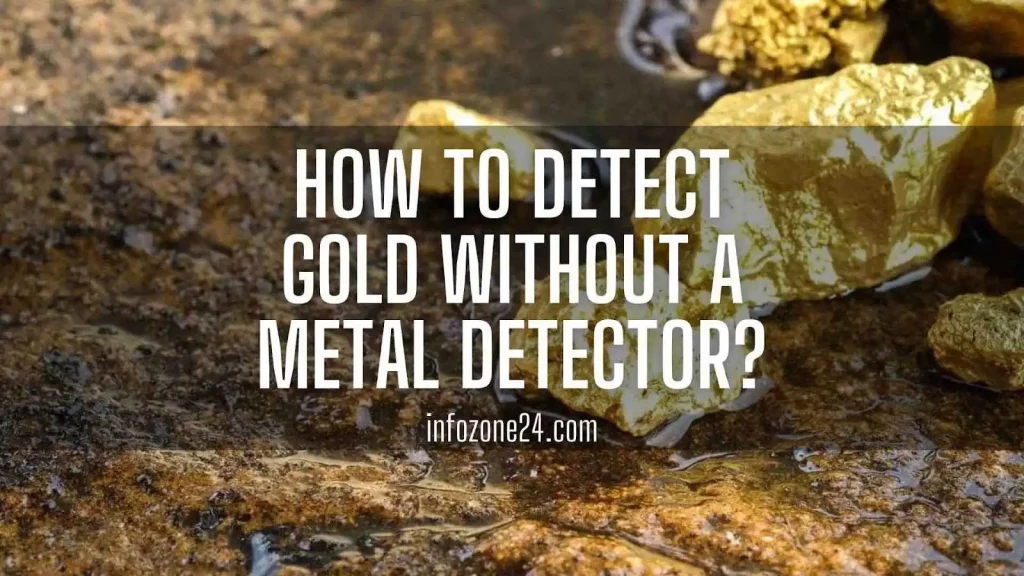Can you detect gold without a metal detector? Nowadays, metal detectors are a common tool in the modern prospector’s collection. However, there are still ways to detect gold without using technology.
In this article, we’ll explore the question: how to detect gold without a metal detector? We’ll uncover the geological signs that hint at hidden riches. Moreover, we’ll provide practical tips to enhance your prospecting adventures.
So, let’s get started!
Is it Possible to Detect Gold Without a Metal Detector?
Finding gold without metal detectors might seem like a throwback to the old days. However, gold prospecting without such devices is certainly possible. Gold detection relies on your ability to observe natural geological signs. And understand the environments where gold is typically found.
Prospectors often detect gold by panning in creeks or rivers. It’s an age-old technique that can still yield twinkles of this precious metal.
When you’re out to find gold, it’s important to research historical gold-producing areas. These can guide you on where to prospect. Stream beds or ancient river channels are potential gold-laden locations.
Although metal detectors accelerate the process of detection, they’re not necessary to find gold. You’ll rely on manual techniques for gold prospecting to sort through residue and pan for gold flakes.
You might be tracking subtle changes in soil color or the accumulation of black sand. This can indicate natural gold deposits. You need to pay close attention to these clues. This might lead you to detect metal of significant value without advanced detectors.
Remember, finding gold without technology might increase the challenge. However, the thrill of prospecting is very rewarding.
What Are the Natural Geological Signs That Indicate Gold Presence?
Even without the gold metal detectors, you can still find the hidden gold deposits. In areas where gold mining is historic, or even ongoing, you can find gold by looking for quartz veins. Often, these white or grey streaks in the rock hold the key to finding gold deposits. Not all that glitters is gold. But in mining regions, sparkling soil can lead you to areas where gold has been found before.
Another classic method in gold prospecting without a metal detector is panning in stream beds. Here, the density of gold has caused it to settle over time. The natural accumulation of gold tends to occur at the inside bend of rivers where the water slows. Here, heavier materials, including gold, settle and can be found amongst the sediment.
Additionally, iron-stained rocks are tell-tale signs. The hydrothermal activity also accompanies gold formation. This often leads to red or yellow soil and rocks.
By combining these clues, you can succeed in gold mining efforts. You can locate valuable areas rich in gold. Perhaps even without ever having to switch on a metal detector.
Techniques for Finding Gold Through Visual Prospecting

You might be keen on learning how to find gold without relying on gold metal detectors. Well, visual prospecting is a crucial skill set to develop. The metal detectors can significantly enhance gold prospecting efforts. However, they’re not always necessary.
You Need to Scan the Surrounding Carefully
How does detecting gold through visual means work? You need to carefully scan the surrounding environment for natural indicators. Also, you have to understand geological signs for successful gold prospecting without the use of metal detectors.
You Should Be Able to Distinguish Metal Types
Various metals in the Earth’s crust can provide clues. However, if you’re targeting gold, it’s necessary to distinguish between different metal types.
You Can Search for Mineral-Rich Areas
Gold often accumulates in places where heavier metals settle. So, searching for indications of mineral-rich areas is a useful strategy.
Why You Should Know the Soil Types and Mineralization in Gold Prospecting?
Are you engaging in gold prospecting without the gold metal detectors? You need to understand the role of soil types and mineralization.
The Earth’s crust is full of minerals that’ve been intertwined since ancient times. In places where gold mining stories are abundant, you can spot the gold without the need for a detector.
Different soil types offer clues. For instance, highly mineralized ground could indicate potential gold presence. It’s the subtle changes in the Earth’s fabric that can lead you to places where gold can be found.
Metal, in its raw form, interacts with its environment. This leads to mineralization that can signal its presence.
Keep learning about gold mining and begin to differentiate between soil types. You’ll develop an intuition for where gold might be hiding. the mineralization patterns can help you identify gold-rich areas. Even without gold metal detectors.
A persistent prospector, armed with knowledge, can single out these hotspots. You can become an expert at spotting areas where metal has been found historically. Without ever needing to scan the ground with a detector.
What Is Gold Panning?
Gold Panning is a traditional method of gold detecting without equipment. This method has been instrumental in finding gold in streams and riverbeds for centuries. It requires patience, but it’s simple enough.
By swirling sediment within a pan, gold sinks to the bottom due to its density.
You can hone your skills in gold panning to detect flakes and nuggets without metal detectors.
Moreover, understanding soil types and recognizing natural geological signs can enhance success rates. They guide you to areas where gold is more likely to settle.
Expertise in identifying gold-bearing areas, combined with the absence of a metal detector, increases the thrill of the chase.
How to Find Gold in Creeks and Streams Without Metal Detectors?
Well, exploring the brisk waters of creeks and streams can make gold prospecting more exciting. When you’re in areas known for gold, you must have keen observation and a bit of know-how.
Gold prospecting in these places isn’t just about seeking shiny specks. It’s about reading the site and recognizing the natural signs that might lead you to find gold.
You need to focus on sections where heavy gold might naturally settle. Without the aid of detectors, rely on techniques perfected over generations. And panning is the foremost among them. It is a classic method. It allows you to detect and collect gold by separating it from sediment and gravel in streams and creeks.
Also, you need to pay attention to soil types and areas of mineralization. This can further guide your prospecting efforts. These factors can indicate where gold might be hiding.
Limitations of Metal Detecting for Gold

Of course, metal detecting for gold is a popular endeavor. However, there are some limitations to the capabilities of a gold detector.
- One significant restriction is the depth at which most detectors can sense gold. They may not penetrate deeply enough to discover larger nuggets or veins.
- Moreover, using a metal detector in rugged terrain or areas with dense plants can be challenging.
- In December, conditions are harsher. So, these limitations become more noticeable. This makes metal detecting more difficult.
- Furthermore, not all gold-bearing areas will yield signals detectable to standard metal detectors. This is due to the mineralization of the soil.
This can lead you to seek alternative methods for detecting gold without relying on detectors.
Alternative Methods for Gold Prospecting
Here are the alternative methods and strategies to use instead of metal detecting:
Know The Geological Formations and Soil Types
You need to understand the geological formations and soil types. This enhances the chances of success. There are techniques that can be a reliable alternative when detectors are not viable. Such as visual prospecting.
Panning Is Always a Viable Method
Additionally, gold panning remains a viable method for gold detection without equipment. It’s a traditional technique that requires patience and skill. But it could reveal gold deposits in creeks and streams. Here, electronic detectors might not be practical.
Ultimately, these alternative methods offer a complement to the limitations posed by metal detectors.
Examining Old Mines and Prospecting Sites for Finding Gold
Are you trying to find gold without the aid of a metal detector? Well, examining old mines and prospecting sites can be incredibly fruitful.
These historical gold mining locations are often filled with clues of past successes in gold prospecting. This makes them prime spots to find gold.
You need to carefully analyze the fragments of mining activities. Such as abandoned equipment and mine tailings. You can even discover gold that was overlooked or discarded.
Prospecting these old sites takes a keen eye for natural geological indicators. These may signal the presence of gold. The soil types in these areas can also be a rich source of information. They may bear the signs of mineralization that typically accompany gold deposits.
Final Thoughts
So, is it possible to detect gold without a metal detector? A keen eye and knowledge of how to find gold in creeks and streams can replace the lack of metal detectors. However, you must acknowledge the limitations of prospecting for gold without metal detectors.
Prospecting for gold doesn’t always require the use of sophisticated detectors. It might be contrary to what you might think. But, various non-technical tools and simple detecting strategies can help you find gold without relying on modern equipment.
Gold prospecting without the aid of a gold detector requires smart strategies. Especially when exploring the places where metal detectors are impractical or can’t reach.
Benjamin is a passionate expert on gold, diamonds, and jewelry with over 10 years of experience in the industry.
He is a certified gemologist and appraiser. Benjamin is committed to providing his readers with accurate and up-to-date information on gold, diamonds, and jewelry.



